Reading the Water
Mike Doughty photo
SOME WATER that is easily fished during a hatch is tough to blind-fish with consistent success. Stream reading is a vital skill for prospecting, but you should approach a day of fishing with the philosophy that not all places in a stream hold trout, and others that may hold trout cannot be blind-fished easily.
When you cast to rising fish, you know exactly where each fish is, you have a good idea what they’re eating, and you stalk one fish at a time. You know the fish are willing to feed, and if your casting is accurate you know they can see your fly. On the other hand, when blind-fishing, you must constantly keep two questions in mind: Can he see my fly, and can he see me? If he sees you before he sees your fly, the fish will be spooked, and even if he doesn’t bolt for cover he won’t be interested in eating. You must have confidence in your ability to locate unseen fish, and you must be able to make a decent presentation to the narrow range where a suspected fish can see your fly.
■ライズしている魚にキャストするとき、魚がどこにいるか、何を食っているかをよく把握して、一匹ずつ忍び足で近づくのが正しいやり方だ。魚が採餌しようとしていることが分かり、キャスティングが正確なら、魚がフライを見ていることがわかる。一方、君の釣りがblind-fishingなら、いつも次の2つの質問を心に留めよ。魚は私のフライを見えているのか?もし、魚がフライよりも先に君を見つけたら、魚は臆病になりすぐに物陰に逃げ込まないまでも、採餌に興味を失ってしまうだろう。見えない魚を見つけだすことに自信を持たねばならない。用心深い魚が見つけ出せる狭い範囲に、適切なプレゼンテーションでフライをキャストしなければならないのだ。
In general slow water is the hardest water to fish blind, for a number of reasons. Slow water is more difficult to read, because in big pools you don’t have the benefit of differing currents to narrow the possibilities of where you may find a trout. In a riffle or run much of the water is too fast for a trout holding in place, and some of the water is also too shallow. Trout will be found in narrow, easily recognizable bands where fast water meets slow, deep water meets shallow, or rocks or shelves offer relief from the current. It is difficult to cover slow water without spooking the fish, because fish in slower currents get a much better look at the outside world and the food they’re eating. In a riffle you can drop your line right on top of a trout without spooking him, so a thirty-foot drift will effectively cover thirty feet of water. In slow water, though, a thirty-foot drift will cover a maximum of fifteen feet, the length of the longest leader most of us can handle, and the trout lying under the fifteen feet of fly line will probably be spooked. Frankly most of us lack the patience to blind-fish slow water. The fly drifts so slowly that we lose interest and confidence in what we are doing.
■一般に、ゆったりした流れはブラインドフィッシングが難しい水域だ。それには幾つかの理由がある。大きいプールで魚がいそうな場所を見極めるために必要な「水の流れの相違」を見分けることが難しく、ゆっくりした流れでは流れを読むことが難しいからだ。浅瀬や瀬、淵は鱒が定位するには流れが速すぎるし、また水深が浅すぎるところもある。鱒は、速い流れとゆっくりした流れがぶつかるところ、深い流れが浅い流れに出会うところ、岩や棚が水流を弱める帯状の場所にいる。でも、ゆっくりした流れの魚は外界とエサを非常によく見ているので、脅かさないでゆっくりした流れの全域をカバーする釣り方は難しいのだ。瀬では、鱒を警戒させないで、ラインを鱒の頭上に落とすことができる。でも、ゆっくりした流れでは30フィート(10m)のドリフトで、最大15フィートの範囲(我々が使う最長のリーダー)をカバーできるが、フライラインから15フィート下流にいる魚は恐らく用心深くなってしまうだろう。率直にいえば、多くの人はゆっくりした流れを釣る(blind-fish)ための忍耐力が不足していると言える。フライがゆっくり漂うので、自分のしてることに興味も自信も持てなくなるのだ。
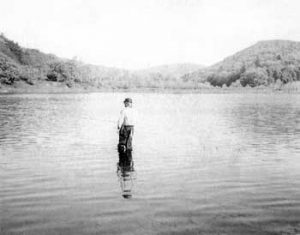
A giant slow pool, like this one on the Delaware, is difficult to read and to prospect for trout in.
You’ve seen fish rising in your favorite pool on another day when there was a good Sulphur hatch, so you know exactly where they are lying, right? Sorry. Those fish may be lying below the same spot you saw them rising, but in slow water, especially during a heavy hatch or spinner fall, trout often move from their normal lies into places where they can capture floating food with greater ease.
■モンキチョウ(Sulphur hatch)がたくさん羽化した別の日に、お気に入りのプールでライズする魚を目にしたことがあるから、魚の休んでいる場所は正確に分かるだろう?申し訳ない。その魚は、君が目撃したライズ下で眠っているかもしれない。でも、ゆっくりした流れの中では、特に羽化やスピナーフォールのときは、鱒たちは通常の隠れ場から気軽に浮遊する餌が取れる場所へ移動していることが多い。
There are ways of finding trout in slow water, which we’ll explore a little later in this chapter, and there are methods of fishing that work in slow water, which I’ll talk about in later chapters. Vermont’s Battenkill has miles of slow, deep water that I have tried to blind-fish with a nymph or dry during every month of the season, but I find myself spooking an entire pool before I can get a fish to look at my fly. Where a riffle punctuates the slow water, I’ll do fine, but between the infrequent fast water I find myself relying on streamers, which can be fished independent of the current and for which trout will move from ten or even twenty feet away. On the other hand, when conditions are right in faster water, I can take trout on dries, wets, nymphs, or streamers.
■この章のあとで述べるが、緩やかな流れで鱒を見つける方法と効果的な釣り方がある。Vernont Battenkill 川(NY州)には数マイルに渡って、穏やかで深く流れる深場があり、そこで私はシーズン中に毎月、ドライとニンフでblind-fishingに行ったが、魚が私のフライに目を向ける前に、プール全体に警戒心を与えていることに気がついた。瀬の緩やかな流れではうまくいくが、まれにしかない速い流れでは、流れに依存しないで釣れ、10フィート、20フィート先からでも鱒が動いてくれるストリーマーに頼ることになる。他方、速い流れでは状況がよければ、ドライ、ニンフ、ストリーマで鱒を釣ることができる。
So prospecting for trout relies heavily on riffles, runs, and pocket water, which is fine because in a heavily fished stream this is the water most fishermen ignore. When there are no hatches, I always start fishing at the head of a pool or run, in pocket water, or in a riffle, and then I graduate to the slower water if I can figure out what is going on. Fish in rough water are less easily disturbed, and they’re also less wise to the dangers of artificial bugs. Trout fishing is supposed to be challenging, but I am quite content with the dumbest, least neurotic trout available if there is no hatch to even the odds.
■鱒を探すには、早瀬、急流、ポケット頼ることが多いが、かなり釣られた川ではほとんどの釣人が無視するポイントなので、問題ない。虫の羽化がないとき、私はいつもポッケトな水域やpoolやrunの先頭、瀬から釣り始めて、状況がわかってから徐々に緩やかな流れに移動する。荒い流れの魚はあまり警戒しない。そして、人工的な虫の危険に対して感づいてないからだ。鱒釣りはチャレンジグなものであるべきだが、羽化が50%の確率しかないなら、私は愚かで神経質でない鱒で満足だ。
Why Trout Need Special Places
When Thomas Jenkins built his artificial channel in Convict Creek, he found that different trout introduced into the channel separately used virtually the same feeding positions, even if a whole new group of trout replaced a previous group. The positions used didn’t offer more food than the unused sites, but Jenkins thought the sites used offered better energetics — in other words, the fish could obtain their food without wasting more energy than they were gaining. Energetics is the basis of learning to read a stream. Trout need enough food passing by their position to have an almost constant supply, yet they need to lie in areas where the current velocity is nearly zero.
■Tomas JenkinsがConvict Creekに自分用の人工水路を完成させるとき、水路に放流された色々な鱒は、新しい鱒の群れが従来の群れと全部入れ替わったときでさえ、同じ採餌場を使っていることが分かった。その使われた場所の方が、使われなかった場所より餌が豊富なわけでないが、使われた場所はよりエネルキー(Energetics)的に優れていると考えた。言い換えれば、大きくなるよりもエネルギーを消耗しないで餌を得ることができたのだ。エネルギー論は「流れを読む」を理解するうえで基礎になる。鱒は近くに流れてくるエサをほぼ一定に保つ必要があり、その上、流速がほとんどゼロのところに定位する必要がある。
Bob Bachman has determined that brown trout prefer to lie in water with a speed from one-quarter to one-half foot per second and feed in water running about two feet per second. Rainbows generally feed in faster water, up to about six feet per second, while brook trout and cutthroats like about the same current speeds as browns. In a stream that offers all four species you’ll often find the rainbows at the head of a pool and the other species in the middle and the tail of the pool, or in places where a large object slows the current. The current at the surface of a tumbling mountain stream might be ten feet per second, the fastest water in an average riffleand-pool lowland stream six feet per second, and the middle of a slow pool at low water approaching that magic half a foot per second. This is why you’ll see trout hanging just below the surface in the middle or tail of a pool during a good hatch or spinner fall at low water — the current is slow enough that the fish can comfortably lie and feed in the same place.
■Bob Bachmanは、ブラウントラウトは流速1/4〜1/2(f/s, フィート/秒)の水流に好み、おおよそ2(f/t)の流れで採餌すると判断している。ニジマスはおおむね6(f/s)までの速い流れを好む。他方、ブルックトラウトとカットスロートは、ブラウンと同じような流速を好む。これらの4種類の魚すべてが生息する小川ではプールの先頭にニジマスが、中間部と瀬尻、または川の流れを妨げる大きな障害物がある場所に他の魚種が見られる。渓流の水面の流速は10(f/s)くらいで、平均的な瀬のある低地の渓流では最も早い流れは6(f/s)であり、低水位のゆっくりした流れの中央では1.5(f/s)という魔法のような速度に近づいている。このため、浅い流れで盛大な羽化やスピナーフォールがある間に、poolの中央部や尾部に水面下をぶら下がる鱒を見ることができる。そこの流れは魚が快調に定位でき、同じ場所で採餌できるほどゆっくりしているのだ。
The usual scenario, though, is for trout to lie in slower current and dart into faster current to grab a piece of food. A fish might lie behind a rock and move to the side, where food is washed around the rock. Another fish might lie on a rubble-strewn streambed and slide up into the faster water just above the bottom. The places to look for trout are areas where fast water meets slow, adjacent to the main current. How do trout find these places? One theory is that they “hear” a particular chord of sounds with their lateral line. Apparently every place in a stream has a unique sound fingerprint.
■でも、通常のシナリオでは鱒はよりゆっくりした流れに定位し、エサをとるためにより速い流れにサッーと向かう、というものだ。ある魚は岩の背後に定位して、岩の周りを流れるエサのある側面へ移動するかもしれない。瓦礫が散らばった流れに定位し、川底の少し上の速い流れにすりあがってくる魚もいる。鱒を探すべき場所は速い流れと緩やかな流れが合流する場所で、本流に隣接しているところだ。鱒はどのようにしてその場所を見つけるか?一説では、鱒たちは側線で特定の音を聞いているという考えた。どうも、川のすべての場所にはそれ固有の音の指紋があるようだ。
You can find the main current by watching the line of bubbles and debris that snakes its way through a pool or run. Look up to the head of a pool and find the fast water spilling into it, then trace its path through the pool to find the places where trout anchor themselves. Understanding stream richness will help you determine how close to the main current trout will be found — in an infertile stream they will be locked onto its edges like cars waiting on a highway entrance ramp. As richness increases they will be found farther and farther away, in the side streets and alleys.
■poolとrunの中を蛇行する水面の泡やゴミに注意を払えば、流芯の流れがわかる。poolの先頭を見て、そこに流れ込む速い流れを調べろ。鱒たちが定位する場所を探すためには、流れ込みの軌跡を探れ。流れの豊かさを理解すると、鱒が本流のどれだけちかいところにいるかを判断するのに役立つ。不毛な川では、鱒はまるで高速道路の入口ランプで待つ車のように、川の端に留まっている。豊かさが増すにつれて、鱒はどんどん遠くへ、脇道や路地へ移動していきます。
Fishermen call these current-speed transition zones seams, and if you know nothing else about reading the water, you can find trout by looking for them. If you board a drift boat with a guide, the first thing he’ll tell you is to hit the seams. Loosely defined, almost any place a trout feeds is a seam, because trout almost always lie in slow water and feed in faster adjacent currents. But seams formed by two currents of different direction and velocity are especially useful because they can help you find trout where there are no bottom obstructions to break the current, or where you can’t see the obstruction on the bottom. When two currents meet, there is always a pocket of relative calm within the turbulence, and often it is enough to form a place where trout can lie and feed in comfort, even when there are no rocks, logs, or shelves. Seams like this form between the slow water next to a bank and the main current, below an island where currents re-form, or along the edges of a fast chute.
■釣人たちはこの流速遷移帯をシーム(seams、潮目)と呼んでいて、君が「流れを読む」以外に何も知らないならシームを探せば鱒は見つかる。ガイドと一緒にドリフトボートに乗ったなら、ガイドが最初に君に言うことは、シームズを狙え(hit)だ。ザックリと言えば、鱒が採餌するほとんどの場所はシームである。というのは鱒はほとんどの場合緩やかな流れに定位していて、隣のより速い流れで採餌している。しかし、方向と速度の異なる2つの流れによって形成されるシームは特に有望だ。というのは、その川底には水流を乱す障害物がないか、または川底に障害物を見つけられないる場所で、鱒を見つけるのに役立つからだ。2つの流れが合流する場合、普通その渦の中に比較的穏やかなポケットがある。岩や倒木、棚がないときでも、そこはしばしば鱒たちが定位し快適に採餌できる場所になる。このようなシームは土手横の緩やかな流れと主流の間、流れが再形成する中島の下、あるいは急流の端に形成される。
Less obvious than horizontal differences in current are the vertical ones. Anytime water encounters an object, friction slows the current and causes turbulence. Water that flows through a smooth pipe is nearly laminar, meaning most of the water molecules are running in the same direction. A trout stream never approaches anything near laminar flow, as the roughness of the streambed, the banks, and objects such as gravel bars and logs slow down the water, deflect the flow from a straight downstream course, and cause turbulence. That is why water in a straight piece of stream is fastest in the center of the river, near the surface. The closer to the banks and the bottom, the greater the friction, the greater the turbulence, and the slower the downstream progress of the water. Not surprisingly, then, in a stream of reasonable velocity without midstream obstructions you find most trout near the banks or on the bottom.
■水流の違いが水平方向ほど目立たないのが、垂直方向である。水流は物体に当たると、その摩擦で流れが弱められて乱流(turbulance)が生じる。スムーズなパイプを流れる水はほとんど層流(laminar)で、水の分子の大半が同じ方向に向かっていることになる。鱒がいる川の流れは川床や土手の凹凸、砂利や丸太によって流れが緩やかになり、下流へまっすぐに流れないので、乱流が発生し、決して層流にならない。そのため、まっすぐな川の水は川の中心部、水面付近で最も速く流れる。一方土手や底に近いほど摩擦が大きくなり、乱流が発生し、下流への流れが遅くなる。だから、中流域に障害物のない適度な速度の川では、ほとんどの鱒は川底や川岸近くで見つかる。
Reading Surface Current
Reading the water is often spoken about as if it’s some kind of voodoo that only grizzled old men who smoke pipes and have many patches on their waders understand. They are supposed to be able to make magic predictions by translating the fingerprints of surface currents into signs that point directly to trout. Stream reading skills do improve with experience, but no good stream reader depends entirely on surface currents; in fact you should only use surface currents if you have no other clues. As a bonefish guide on Christmas Island told me, “Don’t look at the water, look into it, look through it.” With a decent pair of polarized sunglasses and a little training — teaching your eyes what to look for — you’ll be able to see deeper into the water. You’ll also be able to spot trout on those rare occasions when they are visible. Don’t think it takes vision like The Man of Steel’s, either. It just takes experience learning what to look for. My eyesight has always been poor, and I wear strong contact lenses so that I can use polarized sunglasses and still take them off when it rains. A friend of mine, a commercial shell fisherman, can spot a flock of gulls wheeling over the water at least a half mile before I can, yet when we fish together I can spot trout and submerged rocks that he never sees. It’s simply a matter of picking up patterns.
■「流れを読む」ことは、あたかもパイプタバコを咥えて、ツギハギだらけのウェーダーを履いた白髪の老人にしか理解できないブードゥー教のようなものと語られることが多い。彼らは表層流の指紋を、鱒のいる場所へ直接指し示すサインに変換することで、魔法のような予測ができると思われている。川の流れを読むスキルは経験によるが、表層流に全面的に依存して読む人はいない。むしろ、他の手がかりがないの場合のみ、表層流を利用すべきだ。クリスマス島のボーンフィッシュ・ガイドは「水を見るな。その中を見ろ。水を通して見ろ」と、我々に教えてくれた。ちゃんとした偏光サングラスを使い、すこしの練習をすれば、つまり、君の目に見つけるものを叩き込めば、より深く見ることができるのだ。魚が見えれば、まれにしか見られない鱒を見つけることもできるでしょう。それでも、それを鉄男のような視力が必要だなどと思うな。何を探すべきかを知ることが必要なのだ。私の視力はもともと弱く、偏光サングラスが使っても、雨の日は外せるように強いコンタクトレンズを装着してます。私の友人の貝類漁業者は、私が見つけるまえに、少なくとも半マイル離れた水面を泳ぐカモメの群れを見つけることができるが、彼と一緒に釣るとき、彼がけっして見ることのない鱒や水面下の岩を私は見つけることができる。これは単に「パターンを掴む」ということです。
There are times, however, when you’ll have to depend on reading surface currents: when the water is too dirty to see more than a foot into it; when glare that polarized sunglasses can’t block obscures the water, especially in the morning and evening; or in a riffle where bubbles and surface turbulence hide what’s underneath.
■しかし、水が濁っていて水深1フィート以上見えないとき、表層流を読むことに頼らなければならない場合がある。特に、朝夕、偏光サングラスが水面の反射をブロックできないような水面のギラツキがあるとき、あるいは水面の泡や渦が水面下を隠しているような瀬の流れのときです。
Midstream Rocks
Perhaps the most over-studied situation involves a submerged rock surrounded by either sand or gravel, so the rock stands out as an obvious trout haven in an otherwise unattractive spot. When water meets an immovable object, some of the water is stopped dead, and the kinetic energy it had is transformed into potential energy. Water gets potential energy by piling itself higher and gaining , and you can see this at the head of a submerged rock. A bump in the water surface shows you where the rock begins; this bump is always slightly downstream of the rock because the current pushes it. It’s a comfortable place for a trout to live because the current is slowed considerably, yet food is constantly pushed to him. Sometimes the force of the current digs a hole, giving the trout a place to bolt to when an osprey’s shadow darkens the water.
■おそらく最も研究され尽くした状況は、砂や砂利で囲まれた水中の岩についてであろう。そのため、その岩は他の場所にない鱒の天国として際だっているのだ。水が動かない物にあたったとき、その水流の一部は完全に止められて、運動エネルギーは位置エネルギーに変換される。水流はより高く重なって体積を増して、位置エネルギーを得る。水面下の岩の頭でこれが見られる。水面の凹凸は岩が始まる位置を示している。この凹凸は、流れに押されてわずかに岩の頭の下流側にできる。そこの水流がかなり遅くなっているので、鱒が定位するためには快適な場所だ。その上、常にエサがやってくる。ときには、水流で川底に穴ができ、それはサギの影が水面に現れたときに鱒が逃げ込む場所になる。
When water rushes over a submerged object, an area of slower water forms just behind the object, and the difference in velocity causes turbulence. If the water is sufficiently shallow and fast, the turbulence carries to the surface and tells us where behind the rock the area of slower current is located. Trout like these places behind rocks, but not always and not everywhere. When you see standing waves or loads of foam behind a submerged rock, you may not find any trout directly behind it. The current’s force is too great, the swirly turbulence may make it difficult for a trout to hold his position, and the unpredictability makes it hard for him to see and to intercept his prey. The current behind a large rock or boulder may be so slow that it offers little food. Only when the rock is no larger than a television set and the current moderate enough to form gentle swirls behind it are you likely to find a trout with his nose up against the rock.
■水中に隠れた物体に水流が押し寄せると、その物体の後ろに緩やかな流れが形成され、流速の違いによって渦ができる。水深が浅くて水流が十分なら、渦は水面まで伝わり、岩陰のどこに流れの遅い部分があるか教えてくれる。鱒はこうした岩陰を好むが、いつでも、どこでもというわけではない。沈んだ岩の後ろに定常波や泡の塊が見えたとしても、その岩の後ろに鱒がいるとは限らない。流れの力が強ずぎて、渦を巻くような乱流は鱒にとって位置を保つのが難しく、予測不能なので、獲物が見えにくく、獲物を迎撃するのが難しいからだ。大岩や大石の後ろの流れはほとんどエサを提供できないくらいゆっくりであろう。岩がTVくらいで、水流がその後ろに十分穏やかな渦を作るときだけ、岩方向に向いた鱒を見つけることができる。
Many more trout, and bigger ones, feed at the edges of the current that swirls around a rock and near the tail of the plume that extends downstream. I call the downstream end of the V-shaped plume, where it narrows to a point, the ‘focal point,’ and the focal point is usually the best spot of all for trout. Lying here, trout can feed from currents coming around both sides of the rock without fighting the violent turbulence that often forms just behind the rock.
■更にたくさんの鱒、特に大型の鱒が、岩に巻き付く流れの縁や、下流へ伸びる水煙の尾部近くで採餌している。私はV字型の水流の下流終端で、1点に向かって狭くなっている場所を「フォーカルポイント」と読んでいる。通常、このフォーカルポイントは鱒にとって最高の場所である。ここに定位すると、岩の背後にできる激しい渦に苦労せずに、岩の両サイドを回ってくる流れからエサを得ることができる。
Seldom do you find a single rock lying in a riffle or run like a spot on a clean mirror. Usually the mirror is covered with spots of all shapes and sizes, and if most of the bottom is covered with boulders and cobbles, fishermen call it ‘pocket water.’ This stuff is a blind-fisherman’s delight: the trout here usually feed all day long. They are easy to approach, and they are not too picky about their fly selection. Stand off to the side and look for places where the focal point of one nice rock intersects the bump in front of another rock, or where a family of rocks form a minipool with its own bump, edges, and focal point. Because trout feed on drift that comes in front of the rock or slides off to the sides, I avoid dropping my fly in the swirly water right behind the rock, even though it’s tempting to slam your first cast right there. Try it a couple of times and you’ll see why it should be avoided — placing your fly there without dumping piles of slack into the leader will give you almost immediate drag, and a trout may be put off your fly on successive casts, even if they are drag-free. A trout that is lying around looking for food but not preoccupied with a hatch can be spooked much easier by a fly that drags than a trout that is filling his face with bugs. If you begin by placing your fly in front of the rock a few times and then try a drift along each side, it will be easier to get repeated drag-free floats. The water in these places runs uniformly downstream, so it’s less likely that a squirrelly current will make your fly go south when the leader is heading north.
■きれいな鏡上の汚点のように、瀬や淵(run)に横たわる1個の岩を見つけることはほとんどない。普通、鏡表面には様々な形やサイズの汚れがある。川底の大部分が大小の石で覆われていたら、釣人はそれを「pocket water」と呼んでいる。それはBlind-fishermanの喜びとする場所で、そこの鱒は通常一日中採餌している。そこへ接近しやすく、フライの選定にも厳しくない。横に立って、素晴らしい岩のフォーカルポイント(焦点)が、別の岩の前のコブ(bump)と交差している場所や、岩のファミリーが独自のコブやエッジと焦点を持つ小型プールを形成している場所を探せ。鱒たちは石の前へ来たり、密かに脇に来たりしながら採餌しているので、そこへ「ピシャ」とキャストすることは魅力的であるけれど、岩の直後の渦巻にフライを落とすことを避けている。数回試してみろ。そうすれば、なぜ避けるべきかが分かるはずだ。リーダーに弛みをつくらないでキャストすると、ラインはすぐにドラッグしはじめ、ドラッグ無しでも、繰り返しキャストしても魚はフライを遠ざける可能性がある。羽化した虫に夢中になっている鱒を除いて、エサを探しながらゆらゆらしている鱒は、眼の前が虫で一杯になっている鱒よりも、ドラッグのかかったフライに簡単に警戒してしまう。まず数回、岩の手前にフライを投げ込み、岩の両サイドにドリフトしてみると、ドラッグ無しで浮かすことは簡単であろう。そこの水流は一様な流れなので、リーダーが北方向に流れて、フライが南へ向かうような複雑な流れになることは起きない。
If you just can’t resist plopping your fly in that gurgling mess right behind the rock, don’t use a dead-drifted nymph or dry. Try a streamer, or a skating caddis or spider — something that laughs in the face of convoluted currents.
■岩陰のゴロゴロした水面へフライを「ポトン」と落したくないなら、デッドドリフトのニンフやドライを使うな。ストリーマー、スケーティング・カディス、スパイダーなど、複雑な流れに対応できるものを使ってみよう。
The Head of the Pool — An Easy Spot for Prospecting
Often the water is too deep for you to pick out individual rocks, or the rocks are too small to be differentiated from the characteristic marks on the surface. Even though trout will key in on certain rocks no bigger than themselves, and fish will lie on top of or just behind certain rocks year after year, no one has come up with a formula for predicting what rocks offer exactly the right hydraulics. I hope they never do. When you can’t locate the rocks, you have to use other clues. The head of a pool or run is the first place I go, because the water there is faster than in the rest of the pool, so the fish will be easier to approach and fool. (I never told you we would always force ourselves to do this the hard way, did I?) Water coming into a pool, right in the tongue as it spills over whatever obstruction forms the head of the pool, may often be too fast to hold trout. Without a log or rock to block the current’s force, this part of a pool may be sterile. Usually, though, as the current entering a pool starts to flatten and slow (typically just below the standing waves, if there are any), there will be a shelf, with an area of calm water below its lip. Here trout can hold in comfort and have the pick of the current.
If you can tell me how to get to them in early spring, when there are four feet of raging current above them, then you should be writing this book instead of me. Once in a while, if you twist enough lead in front of a streamer, toss it above the pool, and strip just as it drops over the lip, you might draw one out of the maelstrom. But in the early season the water generally is too cold for a trout to chase anything moving faster than a crawl, so you’re out of luck anyway. You can try those guys under the waterfall in midsummer, when the current barely whispers over their heads. There are easier places at the head of the pool.
■流れが石を識別できないほど深いときや水面上でその特徴がわからないほど小さい石の場合がよくある。鱒は自分たちよりかなり小さい岩に狙いを定め、毎年特定の岩の上や岩の後ろに定位するけれど、どの岩が正しい水流を作り出すかを予測する公式を誰も示していない。そうあってほしい。岩の位置が同定できない場合、その他の手がかりを使うしかない。PoolやRunの先頭が、私がまず試す場所だ。というのは、そこの流れがプールの他の場所より速いからだ。だから、魚は接近しやすく騙されやすい。(いつも難しい方法でやるとは言っていないだろ?)プールに流れ込んできた水が、プールの先頭を形成している障害物を越えて溢れ出すしたとき、その舌の部分が鱒が定位するには流れが速すぎることがよくある。水流を妨げる倒木や岩がなければ、プールのこの部分は無菌状態かもしれない。けど、プールに流入する流れが平らでゆっくりしているなら(通常は定常波があれば、すぐ下)、棚ができ、その縁(lips)の下に穏やかな流れ(浅瀬, shelf))があるだろう。ここでは、鱒は快適に水流に身を任せることができる。
■もし早春、鱒たちの上に水深4フィートの激流があるとき、鱒たちを捕まえる方法を教えてくれたら、僕の代わりに君がこの本を書くべきだ。ときどき、ストリーマーの前に十分な鉛をねじり合わせて、プールの上方に投げ込み、丁度縁(lips)から落ちる瞬間にストリップ(strip)すれば、大渦から一匹引き出せるかもしれない。しかし、シーズンの初期の水温は鱒がcrawl(徐行)より速く動くものを追うためには冷たすぎる。だから、とにかく君はツイてないのだ。流れが殆どなくサラサラ流れているとき、真夏の滝の下でこれを試すことができる。プールの先頭には穏やかな場所がある。
Look at the edges of the fast current on either side of the tongue, the place New Zealanders call the “eye” of the pool. If there is a bend in the river at the head of the pool, as there often is (do you know how hard it is to find a “classic” pool with mirror-image seams on either side?), there will be an inside and outside bend. Where most of the trout will be found depends on current speed. In fast current, where the water on the outside bend smashes against the bank, you’ll find more trout on the inside. The outside may even be completely sterile. I once coveted a spot on a favorite trout stream where the current plowed up against the far bank, carving a dark undercut. I never saw a trout rise there and never hooked one blindfishing, so I assumed there was a monster brown in residence. One steamy August day when even bobbing away in an inner tube looked inviting, I put on a diving mask and poked around. I was disappointed. Not only were there no trout in a place I had paid much attention to over the years, the bottom was as smooth as a beach pebble and offered not one place for a trout to get out of the current.
■舌のどちらかの側の流れの端を見ろ(ニュージーランド人が「プールの眼」と呼ぶ場所の速い流れの縁)。プールの先頭に、カーブした流れがあるなら(どちらかの側に鏡像の境界がある古典的なプールを見つけることがどのくらい難しいか、君は知っているか?)、内側と外側の曲がりがあるなずだ。多くの鱒が見れる場所は水流の速度による。外側へ曲がる流れが土手に激しくぶつかるような速い流れでは、大半の鱒は内側に見られる。外側はまったく不毛 (strile)だろう。私は以前、お気に入りの川で、流れが土手がぶつかって薄黒い削り取られた場所のある穴場がほしかったことがある。でも、そこでは鱒がライズするのを一度も見たことがないし、blindfishngで鱒を釣り上げたこともない。それで、モンスターブラウンがそこに居付いていると想像していた。8月のある蒸し暑い日に、タイヤチューブをプカプカ浮かせことさえ魅力的にみえて、潜水マスク装着して水面に顔を突っ込んだ。何年もの間、注目してきた場所にまったく鱒がいなかっただけでなく、川底は海岸の小石のようになだらかで、鱒が流れからでてくるような箇所はまったくなかった。
On the other hand, if the current is so slow that leaves and other debris collect on the inside of the bend, you’ll find more trout on the faster outside, where the meager current will bring them the most food. In streams with poor to average fertility you would expect to find trout where there is at least some current to bring them food, but in a rich river trout can be anywhere, including those neglected backwaters. Also, if the head of a pool is formed by a gentle riffle rather than a slick tongue of fast water, you’ll find trout distributed all across the riffle, not just at the seams on both sides of the tongue.
■逆に、その流れがカーブの内側に葉っぱや他の障害物が蓄積するくらいゆっくりしていたら、僅かな水流がたくさんのエサを運んでくる、外側のより速い流れに鱒が多いだろう。豊穣さが平均以下の流れでも、少なくともエサを運んでくる流れに鱒がいると期待できるが、豊かな川では、無視される淀みを含めてどこにでも鱒はいる。また、先頭が速い流れでなめらかな舌状というよりも、穏やかな瀬が形成されているなら、その舌状の流れの両側の縁だけでなく、瀬の全域に渡って鱒が分布している。
Turbulence is what makes the head of a pool easier to fish. At the tail of a pool, and usually in the middle, the water velocity is stratified: faster water is at the top, where your fly enters, and much slower water is near the bottom, where the trout lie. When you cast a dry fly upstream in the tail of a pool, the water closest to you is accelerating before it dumps over into the next pool or riffle, so drag sets in almost as soon as your fly lands, making it move unnaturally.
■乱流はプール先頭が釣りやすいのは、乱流のおかげでだ。プールの後尾、通常は中央部では、水流の速度は層を成している。より速い流れが君のフライの上部にあり、鱒が定位している川底近くにはよりゆっくりした流れがある。ドライフライをプールの後尾から上流にキャストすると、手前の流れが加速して次のプールや瀬に流れ込むので、フライが着水すると直ぐに抵抗がかかり、不自然な動きになってしまう。
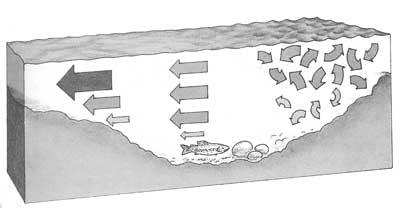
At the head of a pool water velocity is more uniform in a vertical cross section; it stratifies in the middle and tail.
When you cast a nymph upstream, it starts to sink, but the leader and line on top of the water are moving faster, so they begin to pull the fly upward, keeping it out of the productive water below and, again, dragging unnaturally. Your choices include dumping a lot of slack into the cast when fishing a dry or nymph upstream, using a technique that is independent of the current, such as a streamer, or using a technique that uses current to your advantage, like a swung wet fly or a skating caddis. If you’re unfamiliar with these techniques, don’t worry; I’ll describe them in later chapters.
■上流に向かってニンフをキャストするとフライは沈み始めるが、水面上のリーダーとフライラインは下層より速く動いているので、フライは上方向に引張られ始め、水面下の魚がいる層に沈み込まないで、不自然がドラッグを発生する。上流に向かってドライやニンフで釣っているとき、キャスト時のラインの弛みを大きくとり、ストリーマのように水流に依らない技術を使ったり、またスイングウェットフライやスケーティング・カディスのように流れを利用するワザを使うなど、選択肢は多岐にわたる。これらの技術に詳しくなくても心配するな。後の章で説明する。
At the head of a pool or riffle, though, turbulence mixes the currents so they’re much less stratified. The downstream progress of the water is impeded, making it easier to slip a nymph through the currents or to get a drag-free float with a dry fly. And you can still swing a streamer or wet fly through these currents, so your options are doubled.
■プールや瀬の先頭では乱流によって流れが混ぜられるので、流れの複層状態は非常に小さくなる。下流方向への流れは妨げられるので、流れにニンフを落としたり、ドライフライを抵抗なく浮かせることは簡単になる。ストリーマやウェットフライも可能なので、選択肢は2倍になる。
Riffles and Soft Spots
Plain, boring old riffles are some of the easiest and most productive places to blind-fish, because the way the water moves conspires against the trout. Current speeds seem uniform both vertically and horizontally: the many cells of turbulence are so small that they produce, for practical purposes, a uniform body of water, lessening drag on a dry fly or a nymph. Contrast a riffle, with its many tiny goose bumps of turbulence showing on the surface, to a boiling slick, where the turbulence cells are larger, big enough to grab your leader and wrench your fly. In a boiling slick the turbulence may even be strong enough to push a trout out of position constantly. Since trout like predictability, if they have to fight for position or they can’t accurately take a piece of food, they’ll move in a hurry. Unless I’m streamer fishing or I have seen a decent trout rising in them (which is seldom), I avoid boiling slicks like a bank full of worm fishermen.
瀬と緩やかな流れ
■平凡で退屈な瀬はブラインド・フィッシングで最も簡単に釣れる場所の1つだ。なぜなら、その流れが鱒にとって不利だからだ。その流速は垂直方向と水平方向の両方向に一様で、乱流の細胞は非常に小さく、実用上は均一の水の塊になるので、ドライやニンフフライに掛かる抵抗は小さくなる。一方、水面にたくさんの細かなさざ波のような乱流のある瀬(boiling slick)では乱流の細胞は大きく、リーダを掴んだりフライをひったくるのに十分な大きさになっている。水面の荒れた流れでは常時鱒を一定の場所に留めない強い乱流があるだろう。鱒は予測可能な環境を好むので、もし鱒たちが場所の取り合いで争ったり、エサをちゃんと採れなかったりすると、急いで移動するだろう。ストリーマ釣りをしているときや、そこでまともなライズを見たことがないなら、ワーム釣師で一杯になった土手のように、私は避けている。
Datus Proper, in his thought-provoking and iconoclastic book What the Trout Said, describes places he calls “soft spots.” These are places where almost anything you do will produce a strike — places that Proper takes rank beginners to bolster their confidence. Every stream I fish has some soft spots, which I have found through experience, and I use them for special guests, children, and impatient or discouraged fishing buddies. All of the soft spots I know are in gentle riffles, lacking either strong whorls of current or the rooster tails of standing waves.
Datus Proper
■Datus Proppeの著書、示唆に富み従来の考え方を打破する本「鱒が言ったこと」では、「ソフト・スポット」という場所を紹介している。そこは、やっとことのすべてが「ストライク(魚が食う)」になる場所で、ズブの素人(rank beginner)に自信をもたせて勇気づけるために、彼らを連れて行く場所だ。 私が釣りをするどこの川にもいくつかのソフトスポットがあり、それは長い経験を通して見つけたもので、特別な客、子供、そして忍耐がないか、落胆している友人にその場所を使っている。私の知っているソフト・スポットのすべては、強い水流の渦も逆立った波もない定常波の水面で、穏やかな瀬にある。
A wide expanse of riffle, whether at the head of a pool or in a transition between pools, seems at first to have no features. Look harder. First you’ll notice seams at the edge of the riffle, and these are worth much of your time and effort. Out in the middle of the riffle, look for slicks — areas that look as though someone polished and flattened the bumps on the surface. Slicks are formed either when the water is too deep for the turbulence formed by contact with the bottom to reach the surface, or when the water is slowed by a plateau in the streambed or an object on the bottom. If there is enough water, all of these places will hold trout. Depth is a limiting factor for trout abundance only when the water is so shallow that trout feel insecure about holding in it. In a riffle the water may be too shallow to hold adult trout, because as a rule they need to have a foot of water over their backs and a nearby refuge. So look for the places where the water is too deep for you to see the stones on the bottom clearly; when looking at slicks, make sure they are big enough or deep enough that a trout can find a place to hide when you stumble up through the currents. A slick the size of a kitchen sink in the center of a shallow riffle might offer all the food and protection from fast currents a trout needs, but a trout won’t stay alive there for long unless the merganser population has flown south for the winter.
■プール(淵)の先頭やプールとプール間にある瀬の拡張部は一見して特徴がまったくないように見える。しかし、しっかり見て。まず、瀬の端のシーム(継ぎ目、seams)に気が付くでしょう。そこは時間と労力をかける価値がある場所です。瀬の中央部では、スリック(表面の凹凸を研磨して平になったような水面)を探せ。そこは誰かが水面を磨いてデコボコを平らにしたように見える場所だ。これは、水深が深すぎて水底との接触による乱流が水面まで達しない場合、あるいは、川床の台地や障害物によって水流が緩められる場合に形成される。水量が十分なら、すべての場所に鱒がいるだろう。水深が鱒の制限要因になるのは、鱒が定位することに不安を感じるくらい水深が非常に浅い場合だけだ。なぜなら一般的に鱒の成魚は背中から1フィートの水深と近くに避難場所が必要とするのが原則だ。だから川底の石がはっきり見えるくらいの水深の場所を探せ。Slicksを探すときは流れによろめいたとき、鱒が身を隠すことが可能な場所が見つけることができるくらい広くて深いことを確認してください。浅い瀬の中央にある流し台サイズのスリックは、鱒にとって必要な早い流れからの保護とすべてのエサを満たしているかもしれないが、冬の間、マガン(鳥)の群れが南へ飛んでいかない限り、鱒はそこで長くは行きられないだろう。
If you can find a slick the size of a bathtub with secure cover nearby, you may find a trout that everyone else has missed. I remember one place in a shallow riffle I must have walked through fifty times without a cast. There was an old dead tree trailing in the riffle, and at the downstream end was a tiny pocket, barely deep enough to cover my ankles. I stared and thought I could see bare stream bottom, but I cast a Gray Fox Variant anyway. A brown shape formed seemingly out of the gravel, rose to meet the fly, moved without apparent haste to the tangle of branches, and broke my leader. I have been back to the same place another fifty times and have not seen that trout again.
■バスタブサイズのSlicksで、近くに安全なカバーがあれば、皆が見逃している鱒を見つけられるかもしれません。私は、一度もキャストしないで50回通ったであろう浅瀬の、ある1つの場所を覚えています。流れの中に引きずられる枯死木があり、その下流の端に、私のくるぶしを辛うじて覆うほどの水深の小さなポケットがあった。私はじっと見ていると、川底がむき出しになっているのが見えたが、とにかくGray Fox Wariantフライをキャストした。すると、砂利底からどうやらブラウン色の影が現れ、フライに向かって上昇し、急ぐこともなく枝の絡まるところに移動し、リーダをブッちぎった。同じ場所に更に50回通ったが、再びその鱒には二度と会えなかった。
The Middle of the Pool
The middle of a pool also often looks featureless, without the obvious seams between fast and slow water that guide you to trout at the head. If there is nothing else to guide me, I can find the best fish in the middle of a pool by tracing the main threads of current down through it. Look up to the head and follow the line of bubbles and debris carried by the current, and you’ll see the best feeding positions. Even if the places where the main current flows are shallower or offer less cover than water off to the side, you’ll find more trout, and especially more feeding trout, where the current brings a constant stream of food.
プールの真中
■プールの真中には特徴がなく、水流が速いところと遅いところの境界がはっきりしないので、水際の鱒を誘導することができない。導くものが他に何もない場合、私はプールの中流域で、流れの主要な筋(thread)をたどって一番の魚を見つけることができる。上流方向を見て、水面を流れる泡や浮遊物の軌跡をたどれば、ベストな採餌位置が見えてくる。脇の水より、流れが浅いか、カバーが少なくても、流れが絶えずエサを運んでくる場所では、もっと鱒、特に採餌する鱒を見つけることができる。
Look on the bottom for lines of color that show a dramatic change in depth. Trout may hide in the dark depths when you stumble through a pool, but deep water doesn’t offer much food. If the depth suddenly changes from eight feet to two feet, all the food being carried by the current is forced into a narrow vertical choke point, and a trout here can see all the food that the current carries. In the bottom of a hole he can see only a fraction of it. Look too for rubble on the bottom, as opposed to sand or gravel. The rougher the bottom, the greater the number of nooks and crannies that offer places to hide and pockets of slower water, energy-efficient places for a trout to live and feed. If the water isn’t too slow or too shallow, you’ll be able to spot these places if you can’t “see” into the water by reading the roughness of the surface.
■水深が急激に変わることを示す川底の色違いの線を探せ。君がプールの中をよろめきながら歩いたとき、鱒は深場で身を隠している。でも、深場の流れはエサをたくさん運んでこない。もし水深が8フィートから2フィートに急激に変化するなら、その流れで運ばれてくる全エサは垂直の狭い場所へ押され、そこにいる鱒は流れが運んできたすべてのエサを目にする。ホール(hole)の底では鱒はその一部のみが見える。砂や砂利に対照的なものとして川底の瓦礫を探せ。川底が荒ければ、魚が身を隠す場所、ゆっくりした流れのポケット、鱒が生き採餌するための効率的な場所である隅っこや割れ目がたくさんあることになるのだ。もし水深が浅過すぎず流れが遅過ぎないなら、水面が荒れて流れを読むことができなくても、それらの場所を見つけることができる。
Don’t Ignore Springs . . .
In the early and late season a spring or small tributary entering a pool will concentrate the fish. Springs reflect the average mean temperature of a given latitude, and because of the insulating effect of the ground they hold a constant temperature year-round, just as your basement does. So in early spring, when the river water is 45 degrees, the temperature of an entering spring could be closer to 50, a more comfortable temperature that will encourage more feeding. In August, when the temperature of the river is 72 degrees with a corresponding decrease of oxygen, the spring will be around 55 degrees, and it may often be a question of survival rather than mere comfort that keeps trout with their noses stuck into the cold water. The Firehole in Yellowstone Park is a river that suffers from high summer water temperatures because of the hundreds of geysers, mud pots, and boiling water pools that flow into it. One August day I found a cold spring flowing into the Firehole opposite the famous Ojo Caliente hot spring. There were more than twenty trout packed into a shallow, barren flat below the spring, and they were unusually spooky, but I found that a tiny Pheasant Tail nymph dropped into the crowd would get a nod if I rested the pool after the previous fish I’d taken. It was the first time I had fished the Firehole, and had I not wanted desperately to catch a trout there, I would have left them alone, as they were vulnerable and stressed by living in this crowded, exposed environment. Since that day I have avoided cool springs in extremely hot weather, preferring to fish near them only when a couple of trout have moved in for comfort, not when an entire pool has migrated there out of desperation. You’re the predator, though, and you can make that decision on your own.
湧き水を無視するな
■シーズン初期と後期には、湧き水やプールに流入する小さな支流に魚が集まる。湧き水はその緯度の平均気温を反映していて、地面の断熱効果のため、地下室のように年中一定の温度を保っている。そのため、川の水温が華氏45F(7℃)の早春に、湧き水の水温は50F(10℃)近くあり、魚の食い気を高める。8月には川の水温は酸素濃度の低下に伴って72F(22℃)になり、湧き水はだいたい55F(13℃)だろう。それで鱒を冷たい流れに鼻を突き刺しているのは、単なる快適さではなく、生存に問題である場合が多いのです。
イエローストーン公園のFirehole川は、たくさんの間欠泉、泥水泉(坊主地獄)、そしてそこに流れ込む沸騰水がある川り、夏の高水温に悩まされる川の1つだ。8月のある日、私は有名は「Ojo Caliente」温泉の対岸で、Fireholeに流れ込む冷たい湧き水を見つけた。その冷たい泉の下流の浅くて不毛な平瀬に20匹以上の鱒が集まっていた。魚たちは非常に警戒心が高かったが、釣り上げてからプールを休めていたら、魚の群れの中へ投げ込んだちっぽけなPheasant Tail ニンフに反応があることがわかった。それは始めてFireholeを釣ったときことであったが、どうしても鱒を釣りたいと思わなかったなら、鱒は傷つきやすく混雑していて、野ざらしの環境に生きていてストレスがあるので、鱒たちをそのままにしておいただろうき。その日から、私は非常に暑い日に冷たい湧き水で釣ることを避けてきた。プール全体がすっかり移動してしまったときは、釣りをしないことにしている。数匹の鱒が快適に入り込むときのみ、その近くで釣ることが好きだ。捕食者であるあなた方は、自分の意志で決めることができる。
. . . or the Banks
Reading the water by looking at the banks is often ignored, but the banks in many streams (not just meadow streams with undercuts) are the most important fish-holding features. Unless a bank has a shallow slope without cover and is made from fine gravel or the water along it is so shallow that a trout’s back would poke out, you’ll find trout somewhere along this edge. Generally one bank is better than the other. When you’re fishing blind, fish are spookier than if they’re preoccupied with a hatch, and because you’ll have to favor one of the banks when wading up or down (unless the river is so big you have to fish the same bank you’re wading), it’s important to look over both banks before you enter the water.
。。または川岸
■土手を見て、川の流れを読むことは無視されがちだ。でも、多くの川(単にエグれた湿地の川だけでなく)の土手は、魚を定位させる重要な特徴を持っている。土手に隠れる場所がなく、ゆるやかな傾斜で、細かい砂利で出来ているか、岸沿いの流れが鱒の背中が露出するくらい浅くないなら、この縁沿いに鱒をいるはずだ。一般的には、どちらか片方の土手はもう一方より良い。blind-fishingの場合、魚がハッチに夢中になっているときよりも不気味で、ウェイデングで上流や下流へ行くとき(ウェーディングのときと同じ土手で釣らなければならないほど大きな川でない限り)、土手の片方を選択しなければならないので、川に入る前に両岸の土手をサーっと見ることが重要だ。
If the river is so fast in the middle that it is difficult for you to wade, there is nothing to break the current, and there are no twists to make current seams, you can be certain that any decent trout around will be near one or both banks. Which one should you choose? Just as you evaluated the middle of the pool, look at the head of the pool or riffle to see where the current is directing most of the food. Usually the current will bounce the main volume of water toward one bank or the other. But wait, you say;trout don’t need to worry about aquatic insects when they live near the banks because they have plenty of terrestrial insects falling right on top of their heads. It’s true that in some rivers terrestrial insects make up the bulk of a trout’s diet, but contrary to what most fishermen say and believe terrestrial insects are no more important to trout near the banks than to trout in the middle of the river. I remember casting to a large brown trout rising to leafhoppers and beetles in an upstate New York river one windy day, and I counted thirteen fly changes until I got him to take. He was in the middle of the river, fifty feet from either bank. One early morning on the Madison I walked the bank upstream from the Raynolds Pass Bridge. I rose dozens of bigspotted browns on a hopper right next to the bank, but when I turned my attention to the middle, the rainbows on the seams of the fast water ate the hopper just as eagerly.
■ウェイディングが難しいくらい、川の真中の流れが速く、流れを妨害する障害物がまったくなく、流れのシームを作るネジレがまったくないなら、まずまずの大きさの鱒がどちらかの岸の近くにいると確信できる。どっちを選ぶべきか?プールの真中を評価するのと同様に、プールや瀬の先頭を見て、エサの多くを運ぶ水流方向を確認します。普通、川の流れはどちらかの岸に向かって水量を上下させている。でも待って。土手近くに鱒がいるとき、土手近くの水生昆虫に注意を払う必要がない。なぜなら、頭上から落ちてくるたくさんの陸生昆虫がいるからだ、と君は言うのですか?
ある川では陸生昆虫が鱒のエサの大半を占めていることは事実だが、川によっては、多くの釣人が信じているように、陸生昆虫は川中央の鱒よりも、土手近くにいる鱒にとって大して重要でない。ある風の強い日にNew York州北部の川でバッタやカブトムシにライズしている大きなブラウン鱒に向かってキャストし、そいつを釣り上げるために13回フライを交換したことを思い出す。魚は川の中央部にいて、両方の川岸から50フィート(15m)離れていた。マジソン川のある早朝、私はRaynolds Pass橋の上流の土手を歩いた。土手のすぐそばで、バッタので、大きな斑点のブラウン鱒を数十匹釣り上げたが、注意を中層へ向けたとき、早瀬の継ぎ目にいるニジマスが、同じように熱心にバッタを食った。
There is a simple reason for my not thinking terrestrials are more important to fish living near the banks: An object falling into a river is quickly drawn into the center. If a grasshopper or cricket or beetle or ant falls into the water and isn’t eaten right away by a trout living next to the bank, it will soon be available to those guys out in the center. In tiny brooks or shallow streams the deeper bank is usually better. You should make sure, however, that some current is getting to the deeper bank, because sometimes the deep bank is an almost stagnant backwater. Huge trout can use these deep places for refuge, but they don’t eat there, so trying to get one to take is like pitching to a batter while he’s sleeping. If one bank slopes gently up from the river and the other is made from ledge rock or is otherwise steeper, the steep bank is likely to be better. In huge, fast rivers where the current along the deeper bank might be moving at ten feet per second and the water might be twenty feet deep, I’d take a look at the shallower bank first. There might be a trout underneath that twenty feet of fast water, but you’re not going to have much luck getting a fly to where he’ll see it and feel inclined to move for it.
■私が土手近くの魚に陸生昆虫が重要と思わないには、簡単な理由がある。川に落ちた物体はすぐに中心部に引き込まれる。もしバッタやコオロギ、カブトムシ、アリが水面に落ちて、土手近くそばにいる鱒にすぐに食われなくても、中心部の鱒に食べられる。小さい川や浅い川では、通常深い土手の方がベターだ。深い土手はほとんど淀んだ戻り水(backwater)になっていることがあるので、ある程度の流れがあることを確認する必要がある。大型の鱒は避難場として深場を利用するが、そこで食わないのでそこで鱒を釣ろうとすることは寝ているバッターにボールを投げるようなものだ。片方の土手の傾斜が川からゆっくり上がっていて、もう一方が岩棚でできているなど急な場合は、急な岸がベターだろう。巨大で流れの速い川で、深い方の土手の流れが秒速10フィート(3m/s)、水深が20フィート(6m)あるなら、まず浅い方の土手を見ることにしている。その20フィートの速い流れの下に鱒がいるかも知れない。でも、魚がフライを見つけ、そこへ移動したくなるような場所には、運良くフライを落とすことはならないだろう。
Once you’ve identified the better bank, make sure as you fish that you keep your eye on where the good water peters out, as often the good water switches from one bank to another. Because you’re not looking for rising fish but casting to likely stream features, you can sometimes tighten the blinders too much and wade right through some water you should be fishing rather than blundering through.
■いい土手を見つけたなら、良い流れが途切れる場所から目を離さないようにして釣りなさい。いい流れはときどき、こちらの土手から別の土手に変わることがある。ライズする魚を探すのではなく、流れのある場所へキャストするため、何か目隠しを締めずぎて(流れの方に目を奪われる?)、本来釣れるはずの水の中をウェーディングしてしまうことがある。
Any object that breaks up the outline of the bank will increase its attractiveness to trout. Where a deep riffle runs along a bank, look for a point of land that sticks out. Just like a rock in the middle of a river, the point will form two choice places for trout to lie — one just upstream of the point where the water is backed up to form a dead spot, and another area just downstream. If the point sticks out more than a foot from the bank, you might think that the most or best fish will be found close to the bank in the backwater right behind the point. My experience has shown that most trout, and certainly the bigger ones, prefer to lie just inside the seam behind the point. This place makes sense for trout because it offers protection from the full brunt of the current and easy access to food being carried by the current. If you toss a twig into the backwater behind an object, it will whirl around for many revolutions before it rejoins the current, and some fishermen argue that trout like to be in backwaters because they get multiple looks at pieces of food. I think they are more concerned with getting enough to eat than with admiring their next meal.
■土手の輪郭を壊すようなものは、鱒にとって魅力的なものになる。土手に沿って深い瀬がある場合、突出した地形を探せ。ちょうど川の真ん中に岩があるように、鱒が定位するとき、選ぶべき2つの選択が作られる。1つはその岩の上流で、逆流して静止点ができる箇所で、もう1つは岩の下流側だ。もしその点が土手から1フィート以上突出ているなら、そのすぐ後ろの淀みの土手に近いところに、きっと一番いい魚を見つけると、君は考えるかもしれない。
■だが、私の経験では、ほとんどの鱒、特に大型魚はその場所の後ろのシーム(境界)の内側に定位することを好む。その場所は水流の影響を受けにくく、流れによって運ばれてくるエサに簡単にアクセスでき、その場所は鱒にとっては理にかなった場所なのだ。もし、そこに小枝を投げ入れば、流れにふたたび戻る前に小枝は何回転もグルグル回る。釣り人の中には、鱒が背水の陣を好むのはエサを何度も見ることができるからだ、と主張する人もいる。私は、鱒が次の食事に見惚れるよりも、十分食うことに関心あると思う。
I also like to think this is true because getting a fly behind a point of land just inside a fast current and maintaining a natural drift is difficult without throwing piles of slack or adding a six-foot tippet. I’d rather throw my fly into the easier current just outside the point for a longer natural drift and hope the trout just inside can easily slide over and inhale my fly. If he is tucked way back, he may still see my fly and rush over for it. Only after I’ve attempted every permutation of drifts on the outside will I try the nasty water in the backwater.
■速い流れの内側の土手の後ろにフライを持っていき、ナチュラルドリフトを行うには、スラック(たわみ)をたくさん投げたり、6フィートのティペットを付け足さないと難しいので、私もそれは本当だと思いたい。それよりも、その箇所の外側にフライを投げ込み、ナチュラルドリフトを長くし、内側の鱒が簡単にスライドして、私のフライを吸い込むことを期待する。もし、鱒が奥まったところに潜んでいたとしても、フライを見て、突進してくるかもしれない。外側であらゆるドリフトを試してから、淀みの厄介な水面に挑戦する。
Rocky banks are good. A jumble of rocks offers many havens from the current, with plenty of areas of different current speeds and seams. Narrow lanes between rocks concentrate the current — and move the food — into alleys , simplifying feeding. Any kind of vegetation will also make the bank more attractive to trout, even if the vegetation overhangs the water and doesn’t break the current. Shrubs hanging over the water offer trout security from predators. Luckily for fishermen, if there is a tunnel of alders along the bank, trout will not feed way back inside the tunnel but will lie just to the outside of the brush, using the dark interior only if they are frightened. Logs along a bank, whether parallel or perpendicular to the current, offer protection and breaks from the current.
■岩盤の土手は素晴らしい。岩がごろごろしていると、流れから逃れられる場所がたくさんあり、流れの速さと継ぎ目が異なるエリアがたくさんある。魚たちに天国を作る。岩と岩の間の狭い筋路は水れが集中し、エサも移動しやすくなる。たとえ植物が水面からはみ出し、流れを防げないとしても、どのような植物の堤防でも、鱒たちにとって魅力的になる。もし、植物が水面に覆いかぶさっていて、水の流れを妨害してなくてもである。水面に覆いかぶさる低木(shrub)は捕食者から鱒を守る役割を果たす。幸い釣り人に対しては、土手沿いにハンノキのトンネルがある、鱒はトンネルの内側に戻ってエサを食べることはなく、茂みの外側に定位し、怯えたときだけ暗い内側を利用する。土手沿いの丸太は流れに平行か垂直にかかわらず、流れからの保護と休息を提供している。
A tree that has fallen into the water at a right angle to the current, usually with the trunk still attached to the bank, is called a ‘sweeper.’ The best places near a sweeper are at the outside tip of the branches extending downstream along the seam, and in front of the crotch where the sweeper meets the bank. Both places offer breaks from the current and a steady food supply. Often a line of trout extends below the tips of the branches, with the biggest fish upstream and the size decreasing as you go downstream, because a trout will not tolerate a smaller or less aggressive fish in front of it. Downstream of the sweeper is often barren water. If it contains trout, they’ll be much smaller than you’d think, because the sweeper strains food from the current and pushes it to the outside leaving slim pickings to the trout behind.
■水流に対して90度で水中に倒れた木で、通常、その幹は土手に付いた状態のものを「「スイーパー(sweeper)」と呼びます。sweeperの近くでベストな場所は、潮目に沿って下流に張り出す枝の外側の先端と、sweeperが土手と接する木の股の前だ。どちらも流れから逃れられ、安定したエサを供給することができる。鱒の群れは枝の先端より下流方向に見られ、上流に大型魚が、下流にいくにつれて小さくなる。というのは、鱒は自分の前に小さい魚や攻撃性の低い魚を許さないからだ。sweeperの下流は不毛の水域である場合が多い。もし鱒がいても、思ってたよりもかなり小さいだろう。何故なら、sweeperは水流からエサを濾し取り、外側へエサを押し流すため、後方の鱒にはほとんど残らないからだ。
A log lying parallel to the current will probably hold more trout than a sweeper of the same size, because the entire length of the log offers attractive feeding grounds. When I was a teenager, I fished a productive stream that runs through the limestone bedrock of upstate New York. This river had all the attractive haunts a trout stream could possibly offer, but as far as my sampling could determine, one log in particular held the biggest fish. About fifteen feet long and five feet from the bank, the log always held several small trout; two six-inch nubs were left from branches that had been broken off over the years. And anchored at these nubs were the two best trout in the pool, one twenty inches long and the other nineteen. All these trout fed on the outside edge of the log, and even though there was a good five feet of dark, deep, protected water between the log and the bank, I never saw a trout rise and never caught one there.
■同じサイズのsweeperよりも、流れに平行な丸太の方が丸太の全長が魅力的なエサ場になるので、鱒が多く生息しているだろう。10代の頃、ニューヨーク北部の石灰岩の岩盤を流れる魚の濃い小川で釣ったことがある。この川には鱒の川として魅力的な場所がすべてあったが、私がサンプリングした限り、ある丸太に最も大きな魚が集まっていた。長さ約15フィート,土手から5フィートの丸太はいつも小型の鱒がいついている。何年か前に折れた枝には、2つの6インチのコブが残っていて、このプールで最高の2匹の鱒、20インチと19インチ、が居着いていた。これらの鱒はその丸太の外側境界で採餌していて、丸太と土手の間に水深5フィートほどの暗くて深い魚が身を隠せる流れがあったけど、鱒のライズするのを見たことがなく、そこで鱒を釣ったことがなかった。
The subject of banks brings up the question of cover — the degree trout use it, and the amount they need. Anyone who has studied a piece of trout water for any time has seen trout feeding out in the open, away from obvious cover. The energetics of getting enough food seem to be far more important than safety from predators. But even if you can’t see it, you can bet that trout feeding in the open have a place to run to nearby, and that they have memorized the route. Brown trout seem to place more importance than other species on cover, and if they can find a spot that offers food, protection from the current, and cover, they’ll stay close to cover. When you hook a brown trout, he will invariably head for the nearest log or rock. The other day I was fishing a stream that holds both browns and rainbows, and out in the middle of a pool I hooked a rainbow that tailwalked in place four or five times, ran upstream, and then grudgingly headed downstream to be released. I cast to another fish rising in almost the same spot, except this trout streaked downstream before I even knew he was hooked, and he used a submerged root six feet ahead of me to remove the fly from his jaw as cleanly as popping the top off a beer bottle. He swam past me with an arrogant flip of his tail, and left my fly stuck firmly in the root, all before I could begin to strip in my line. As the fish passed, I saw the dark spots of a brown trout along his back.
■土手のテーマは、鱒がカバーをその程度使っているか、どの程度必要性としているかという「カバー(覆い)」の問題が出てくる。鱒のいる川を調べている人なら誰でも、カバーから離れて公然と水面で盛んに採餌している鱒を見たことがあるはずです。十分なエサを得るエネルギーは、捕食者から身を守るより大事のように思われる。しかし、たとえそれが見えなくても、開けた場所でエサをとっている鱒は、近くに逃げ込む場所を持っていて、そのルートを記憶していることは間違いない。ブラウントラウトは他の魚より「カバー」を重要視していようで、餌が得られ流れから身を守ることができて、カバーできる場所を見つけることができたら、カバーの近くにとどまるでしょう。ブラウントラウトをフッキングすると、必ずと言っていいほど近くの丸太や岩に向かう。先日、ブラウントラウトとニジマスが生息する渓流で釣りをしたとき、プールの真ん中でニジマスを掛けたが、4〜5回その場所でテイルウォークして上流に走り、不本意ながらフックを外すために下流に向かった。鱒は私がフッキングに気づく前に下流へ疾走し、私の6フィート前の水中の木の根を使って、ビール瓶をポンと開けるように、顎に刺さったフライを見事に外したことを除けば、ほとんど同じ場所で私はライズしている別の魚に向けてキャストした。その木の根にしっかり絡まったフライを残したまま、ラインを手繰り寄せ始める間もなく、魚は尾を振って眼前を疾走した。魚が過ぎすぎるとき、その背にブラウントラウトの暗い紋様が見えた。
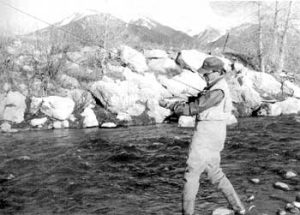
Rainbows will usually be found in more open water, whether it’s riffly like this or slow and smooth.
Brown trout have even been known to burrow in gravel when frightened, but the behavior of frightened rainbows betrays their lack of concern with overhead cover. Rainbows, when spooked, usually head en masse to the deepest part of a pool, and when you walk by you can observe what biologists call “fright huddles” — groups of rainbows all packed together, fins trembling. You never see browns mixed in with them because all the browns have headed to the bank with its more substantial cover. Brook trout seem to use cover less than browns but more than rainbows, so you will more often find them farther from cover and from the bank than browns. Where cutthroats and brook trout are found together, biologists have seen more use of cover by the brook trout. So if you know a river contains only brown trout, spend more time casting tight to the banks than out in the middle. If it holds only rainbows, bless their hearts, you can concentrate on the easier places in the middle of the river. But don’t ever completely ignore the banks. The middle of the Railroad Ranch section of Henry’s Fork in Idaho is essentially featureless, as most of the water is one long flat without big rocks. The better rainbows are near the banks, possibly because of cover, but more likely because the current along the banks is reduced enough to form areas of slower water with access to the food carried by the current.
■ブラウントラウトは怯えると砂利床の中に潜ることで知られていたが、怯えたニジマスの行動は頭上を気にしないことを裏付けている。ニジマスは怯えたとき、生物学者が「fright huddles(恐怖の密集)」と呼ぶ、集団で(en masse)プールの最も深い場所へ向かう様子が観察することができる。一集団になってヒレを震わすニジマスの群れ。ニジマスと混在したブラウンを見ることはない。ブラウンはすべて、もっと十分なカバーのある土手に向かったからだ。ブルックトラウトはブラウンよりカバーを使わないが、ニジマスよりも使うようで、カバーから離れたところでブルックを見かけ、ブラウンより岸から離れていることが多い。カットスロートとブルックが一緒に見られるところでは、生物学者はブルックがもっとカバーを使うと見ている。それで、ブラウンしかいない川では、川の中心よりもっと岸にギリギリにキャストするようにしなさい。ニジマスしかいない川なら、ありがたいことに(bless thier hearts)、川の中央の釣りやすい場所に集中できる。でも、決して土手を無視するな。アイダホのHenry ForkのRailroad Ranch区間は中流域は基本的に特性がなく、その水域の大半は大きな岩のない長く平坦な場所だ。良型のニジマスは土手近くにいるが、おそらくカバーがあるからだろう。でも、それよりも土手に沿った流れが十分に減速し、流れが運んでくるエサにアクセスできるゆるやかな水域が形成されるからだろう。
The Most Difficult Part of a Pool
Everything I’ve said about rocks and banks and logs applies to the tail of a pool as well, and in most of the rivers I’ve fished, the tails hold the largest trout. All the food passing through a pool is channeled at the tail into a vertically and horizontally constricted funnel, and the smooth water here allows a nearly unobstructed view of the outside world, which warns of the approach of all kinds of predators. During a hatch the tail of a pool is the first place I’ll go to catch a trout that will pull line off my reel. It is also the last place I’ll go to prospect. When a trout in the tail of a pool is preoccupied with feeding and you know exactly where he is, approaching him is still difficult; when he is not actively feeding, it is masochistic. Because the tail of a pool is shallower than the middle, look for the deepest place in the tail to hold the most trout, barring any rocks or logs in the water. The place where the tail begins to shallow, where dark water gives way to lighter-colored water, will often be where trout are lined up to feed. If the water close to the banks is deeper than in the middle, and especially when vegetation meets the water, you’ll often find more and bigger trout next to the banks than out in the middle.
プールで最も難しい部分
■岩・土手・丸太について述べたことはプールの後尾部にも当てはまる。私が釣った殆どの川で、テール(後尾部)には大型の鱒がいる。プールを通過するすべてのエサはテールで垂直・水平方向に絞られ漏斗状に集められる。ここは穏やかな流れなので、ほとんど視界を遮るものがなく、あらゆる捕食者の接近を警告してくれるのだ。羽化の時期、リールからラインを引き出す鱒が釣れる一級の場所は、プールのテールである。また、私がプロスペクトのために行く最後の場所だ。プールのテールにいる鱒たちが採餌に夢中で、その場所を正確にわかっていても、鱒へ接近するのは難である。活発に採餌していないなら、マゾ的である。プールのテールが中央部より浅いので、水中の岩や丸太を除いて、大半の鱒がいるテールの深場を探せ。テールが浅くなり、薄く水色が明るい水色に変わる場所は、しばしば鱒たちが採餌で列をなしていることが多い。そこが土手近くの水深が中央部より深く、特に、植物の繁茂が水面まであるなら、中央よりも土手近くの方が多くの、より大型の鱒を見つけることができる場合が多い。
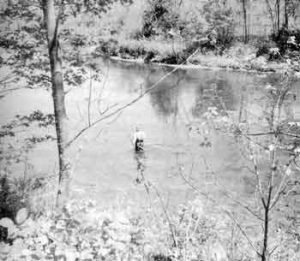
The nastiest part of a pool — the tail.
When you stand at the tail of a pool and fish upstream, following the usual line of attack, the water at your feet is faster than the water you cast into. The water in the tail is always accelerating, particularly in the early season when the current is faster. As soon as your fly lands, drag sets in, and even throwing big piles of slack will not always counteract this problem. You can get a better presentation by casting from upstream or from across-stream and throwing upstream curves, and this works best early in the season when you can get closer to the trout without spooking them. In midsummer I find that from above you spook the fish in the tails of most pools, especially in smaller streams or when the water is unusually low.
■君がプールの後尾部に立って、通常のライン取りで上流に向かって釣りをすると、足元の水の方が、キャストする水より流れが速い。特に、流れが速いシーズン初期においては、テールの水が常に加速している。フライが着水すると直ぐにドラッグがかかり、大きなラインスラックをキャストしても問題の解決にならない。上流からキャストするか、流芯を越えて対岸からキャストして上流側にカーブさせるかで、より良いプレゼンテーションができる。この方法は、鱒たちを警戒させないで接近できるシーズン初期に最も有効だ。真夏になると、特に小川や水深が異常に浅いときに、プールのテールにいる魚を上から見ると、警戒感を与えてしまうことがわかる。
Because most aquatic insects live in riffles, and everything that hatches in a pool that doesn’t fly away will be funneled into the tail (as will any terrestrial insect that falls into the water), trout in the tail of a pool seem more aware of surface food than trout in any other place. If you stand and watch long enough, you will often see them sipping here throughout the day, especially in the low water of late season. This is not really a hatch situation; it is opportunistic surface feeding at every little morsel that drifts by. Sometimes you can watch for twenty minutes before you see a rise, so if you’re moving at a normal pace you won’t spot the fish, and you’ll fish the tail blind. During the summer, when the current has slowed enough, you can often make a short, accurate upstream presentation from a trout’s blind spot. But since your drift will still be short before it drags, decide first where you think the trout will be lying — don’t just blast away at random. It’s a good idea to study the surface currents for several minutes as well. If you can get close enough to where you think a trout might be, and you can figure an angle from which you can get a drag-free float, a terrestrial pattern or small spinner imitation in the middle of the day may rise a trout of a size you would normally see only during the evening hatch.
■ほとんどの水生昆虫は瀬に生息しているので、プールで羽化して飛び去らないものはすべてテールに流れ込むため(この水域に落ちた陸生昆虫も同様)、プールのテールにいる鱒は他の場所にいる鱒より水面のエサを意識しているようだ。土手に立っち止まって長く観察していたら、とくに、シーズン遅くの減衰期では、一日中、sipping(すする)している鱒を見かける。これは羽化の状況でなく、漂うちょっとしたご馳走を、スキを見計らって水面で採餌しているのだ。ライズを見るまで20分間も観察していることもあるので、普通のペースで動いていると魚が見つからず、テール部をブラインドで釣ることになる。流れが十分遅くなる夏の間、鱒の死角から上流に向かって短く正確にプレゼンテーションできることが多い。でも、ドラッグが掛かる前のドリフトの距離はまだ短いので、まず鱒がどこに定位しているかを決めろ。適当に投げ続けるな。そのうえ、数分間水面の流れを検討することはいい考えだ。もし鱒がいそうな場所へ十分近くへ接近できて、ドラッグフリーで流せるところからの角度が分かるなら、日中に陸生昆虫や小さな成虫の擬態パターンは、夕方の羽化時にしか見られないサイズの鱒を、ライズさせることができるかもしれない。
Even in the same stream at the same time of year, you cannot approach the tail of a pool with the casual tactics that might work in a riffle. If you want to catch trout in the tails of pools, study the last chapter on approach carefully. In the technique chapters that follow, note these techniques that have worked best for me in the tails of pools: actively stripped streamers, swung wets, and skated dry flies.
■同じ時期の同じ川でさえ、瀬で通用する日常の戦術でプールのテールに接近できないのだ。もし、プールのテールで鱒を釣りたいなら、最終章の接近について注意深く研究せよ。続く技術編で、プールのテールで私にとっての最善な技を紹介します。ーストリーマーを勢いよく引き、ウェットを泳がし、ドライフライを水面に走らすーに注意して。
How the Setting Can Change
Four minutes from where I sit in an office eight hours a day is a tiny stream that is my laboratory, escape valve, and forty-five-minute retreat. I can fish three or four pools on my lunch hour. In one favorite half-mile stretch I know virtually every fish except the unseen brown trout that I suspect inhabit a couple of deep undercut banks at the base of streamside maples. I have never caught one of these elusive browns, but I imagine them sulking in a tangle of drowned roots, oblivious to my flies but capable of eating a six-inch brook trout followed by a three-day fast. At the beginning of each season I mark a couple of gullible brook trout by clipping their adipose fins so I can follow their progress through the season. If I can figure out where they are living, I can almost always catch them. In early spring they are in the deeper, slower pools, and to catch them you need a large nymph fished close to the bottom, with no drag at all. As water temperatures rise above 55 degrees and flies start to hatch, they will be pulled from the pools into shallow riffles. Now a dry fly will work, as will a wet fly or nymph that swings across the current. As water levels fall during the summer, they can be hard to find, and whenever I fail to catch one that has been in the same spot for a couple of months, I start to imagine my Brooke in an aluminumfoil coffin in somebody’s freezer, or in the belly of a heron or otter. With the lower water levels it’s also likely that there are fewer places in this little stream that can hold trout, and my friends were pushed downstream by more aggressive trout. In summer most of the trout are concentrated in only the deepest holes and in the heads of pools — it may be a hundred feet between places that hold trout.
どのように仕掛けを変えることができるか
■一日8時間座っている事務所から4分のところに、小さな小川が流れていて、そこは私の実験室で、息抜き場所で、そして45分間の隠れ場所だ。昼食時間に3・4箇所のプールを釣ることができる。お気に入りの半マイルの区間では、カエデの根元にある2・3の深くえぐれた土手にいると思われるブラウン鱒を除けば、ほとんどの鱒を知っている。私はそれらの釣りづらいブラウン鱒を一匹も釣ったことはないが、水中に沈み絡んだ木の根っこで拗ねながら、私のフライに気づかず、6インチのカワマスを食べて、3日間絶食する想像してしまう。シーズンのはじめに、私は脂ヒレをカットすることでマークを付して、シーズン中の彼らの成長を追跡できるようにしている。鱒のいる場所が分かれば、ほとんどいつも釣れることになる。早春の川姫鱒は深くて流れの緩慢なプールにいるので、これを釣るためには、ドラッグなしで川底近くに大型のニンフを流す必要がある。水温が55F(13℃)以上に上昇したとき、虫は羽化し始まると、彼らはプールから浅瀬に引き寄せられる。今度はドライフライでもうまくいくだろうし、ニンフやウェットフライで川を横切るのもいい。夏の間、水位が下がると、鱒を見つけることが難しくなる。数ヶ月間おなじスポットにいた鱒を釣り損ねるたびに、誰かのフリーザー中のアルミフォイルの棺に入った自分のブルックや、サギやラッコのお腹の中のブルック鱒を想像し始めます。渇水によって、この小川には鱒がい生息できる場所が少なくなり、私の友人たちはもっと攻撃的な鱒によって下流へ押し出されたのだろう。夏には大半の鱒は深場かプールの先端のみに集まっていて、鱒がいる場所の間は数百フィートも離れていることもある。
During the winter and early in the season trout are more concerned with avoiding anchor ice and floods than they are with eating. There are few insects in the drift for them to capture, and their metabolisms are slowed to the point where they take little advantage of the food that might be available. Shallow water can be scoured by floating ice and anchor ice, which grows from the bottom of the river, so look for trout in deep-water refuges, out of the main current. When there is no ice, though, I have caught them on sunny days in shallow riffles, and because I doubt trout spend the winter in water like this, I suspect they move into places that are warmed by the sun as spring starts to wake up the river. As the water temperature approaches 50 degrees, and insects begin to drift and hatch, the fish migrate to shallow riffles and the heads of pools to take advantage of insect life at its source. You can gauge the migration time by the first major hatch of the season. In the East, if you blind-fish before the Hendrickson hatch, you’ll find most trout in the side eddies and backwaters, but as soon as this first big hatch begins, the trout appear in riffles, in tails of pools, and out in the main current. They’re still there on days when the flies don’t hatch, and early in the morning on days when flies don’t hatch until midafternoon.
■冬からシーズン初期にかけて鱒たちは食うことよりも、低氷(anchor ice)と洪水を避けることに重点をおいている。鱒たちが捕食できるような漂流する虫はほとんどなく、エサが採れる可能性がないので、彼らの新陳代謝はゆっくりしている。浅い水域は流氷や低氷によって川底がこすられるので、主流から外れた深場の隠れ家で鱒を探せ。でも氷がないときは、天気のいい日に浅瀬で鱒を釣ったことがある。というのは、鱒がこのような水域で冬を過ごすということはないと思っているので。春になって川がめざめるとき、太陽によって温められた場所へ鱒が移動するのではないかと思っている。水温が50Fに近づき、虫の漂着や羽化が始まりと、魚は、その発生源の虫の命を狙って、浅い瀬やプール(淵)の先端へ移動する。そのシーズンの最初の大きな羽化から、鱒の回遊時期を判断できる。東部では、Hendricksonの羽化前にブラインド釣りをすると、ほとんどの鱒が両岸の渦と淀みにいることがわかるが、この大規模羽化が始まるとすぐに、瀬やプールの後尾部、そして主流で鱒たちが見られるようになる。ハエが羽化しないときでも鱒はそこにいますし、ハエが昼過ぎまで羽化しない日の早朝にもそこにいる。
There they will stay until low water and high temperatures shrink the comfortable places in a stream and concentrate the trout. As habitats contract, trout don’t move far, sometimes just from one side of the pool to another, or from the middle to the head. In the tail of a big pool on the lower Battenkill, I found a pod of a half-dozen large brown trout one late spring evening, and I returned a couple of evenings a week to work them over. By the middle of the summer I had caught and released most of them, including a couple that I fin-clipped. A vacation kept me away from them for ten days, and when I returned the places where they had been feeding were almost dry. I couldn’t find a single one. One night I happened to look at the other side of the river, which was deeper but had never produced a fish, I guess because this deeper pocket was out of the main current and did not supply enough food. There were several good fish rising there, and sure enough, over the next several weeks I caught some that I had clipped. As I looked carefully at the water, I saw that their new home was deep enough to keep them secure. The current had shifted because of a newly exposed gravel bar, and by the looks of the bubble line coming down through the pool, most of the food was now funneled to the opposite side of the river.
■浅い水深と高水温が小川の快適な居場所を狭め、鱒たちが集中するまでそこに留まることになる。棲息地が縮小すると、鱒はちょうどプールの片方から片方へ、あるいは中央から先端までと遠くへ移動することはない。晩春のある夕方、Battenkill下流の大きなプールの後尾部に、半ダースほどの大型のブラウン鱒の群れを見つけた私は、週に2・3回、夕方に通って、その群れに働きかけた。夏の中頃までに鱒びれをカットした1組を含め、ほとんどを釣り上げてリーリースした。ところが、その後休暇で10日間そこから遠ざかり、戻ったときは鱒たちが採餌していた場所は水はほとんど干上がっていて、一匹も見つけることができなかった。ある夜、たまたま対岸に目に入った。この深いポケットは主流から外れていて、十分なエサを運んでこないと、私は推測した。そのポケットには何匹かがライズしていて、その後、数週間、脂ヒレがカットされた鱒を何匹か釣った。水面を注意深く見ると、新しい住処は魚たちが身を隠すに十分な深さがあり、安全であることが分かった。新たにできた砂利の洲のおかげで流れが変わり、プールを流れる線状の泡を見るとエサの多くは川の反対側へ流れている。
In the tough late season there are three keys to finding trout: temperature, oxygen, and flow. If you remember them, you will catch trout all day long, even in the noonday heat of August when there is slim chance of any kind of hatch.
Temperature: Look for springs entering the river. Even springs whose surface flow runs dry during the summer usually offer some flow below the dry channel, so a scar of clean rocks along the bank that looks as though it might have been a tributary in early spring may tip you off to some cooler water. In general any entering tributary will be cooler than the main river, so look for trout below the confluence of a smaller and a larger stream. Wade wet to find springs entering the river beneath the stream-bed.
■タフなシーズン後半に鱒を見つけるためには、3つの鍵になるものがある、水温、酸素、流れだ。これを覚えておけば、一日中釣れる。虫が羽化する可能性の低い8月の昼間の気温が高いとき、でもだ。
水温:湧き水が流れ込んでいる川を探せ。夏の間、普通水面の流れがなくなる湧き水でさえ、その乾燥した水脈の下に流れがある。それで、早春に支流であったように見える川岸にきれいな石の痕跡があれば密かに冷たい川の流れがあることを教えている。一般的にどのような支流の流れ込みも本流より水温が低くいので、小川と大河の合流点の下流で鱒を探します。水中を歩いて、河床下から川に入ってくる湧き水を探します。
Oxygen: Water’s oxygen content is inversely related to its temperature, so if you can’t find the cooler water, which holds more oxygen, look for places where oxygen is forced into the water by physical means. Riffles, runs, pocket water, the bases of dams — trout will move to these places in midsummer, often leaving the rest of a pool barren.
酸素:水中の酸素含有量は水温と反比例する。もし、もっと酸素を多く含む冷たい流れが見つからないなら、物理的方法で水中に酸素を強制的に取り込んでいる場所を探せ。Riffles(瀬)、Runs, Pocket water,ダム底など ー真夏は鱒たちはこした場所に移動し、プールの他の部分は不毛になっていることがよくある。
流れ:真夏の鱒釣りで、見落としがちなファクター。鱒はエサのないところに居たくないし、水位が低い間、彼らの選択は限られているので、流れが読みやすい。特に流れの穏やかなプールでは、線状の泡の真下以外では鱒を探さないことだ。なぜなら、線状の流れは主流のみが十分なエサを提供している点にまとめられるからだ。もし線状の泡が見つからなかったり、役立つように見えなかったら、鱒を見つけるための他の方法は川底の石を見ることである。以前、野生のニジマスで有名な川を釣ったとき、春になると、たくさんの鱒が集まる荒瀬に入ったことがある。最初瀬の全体像が見えず、どこからスタートすべきか分からなかった。水面をじっと見ていると、あることに気がついた。川底の大半の石がシルトのように薄い膜で覆われていたが、少し深くて流れが速いところでは、岩はキレイに拭き取られていたのだ。そこで、きれいな石の狭い筋へFlashabou Caddis Larva フライを投げ入れると、平で浅い瀬とは思えないほど、10インチの魚を6匹釣り上げることができた。

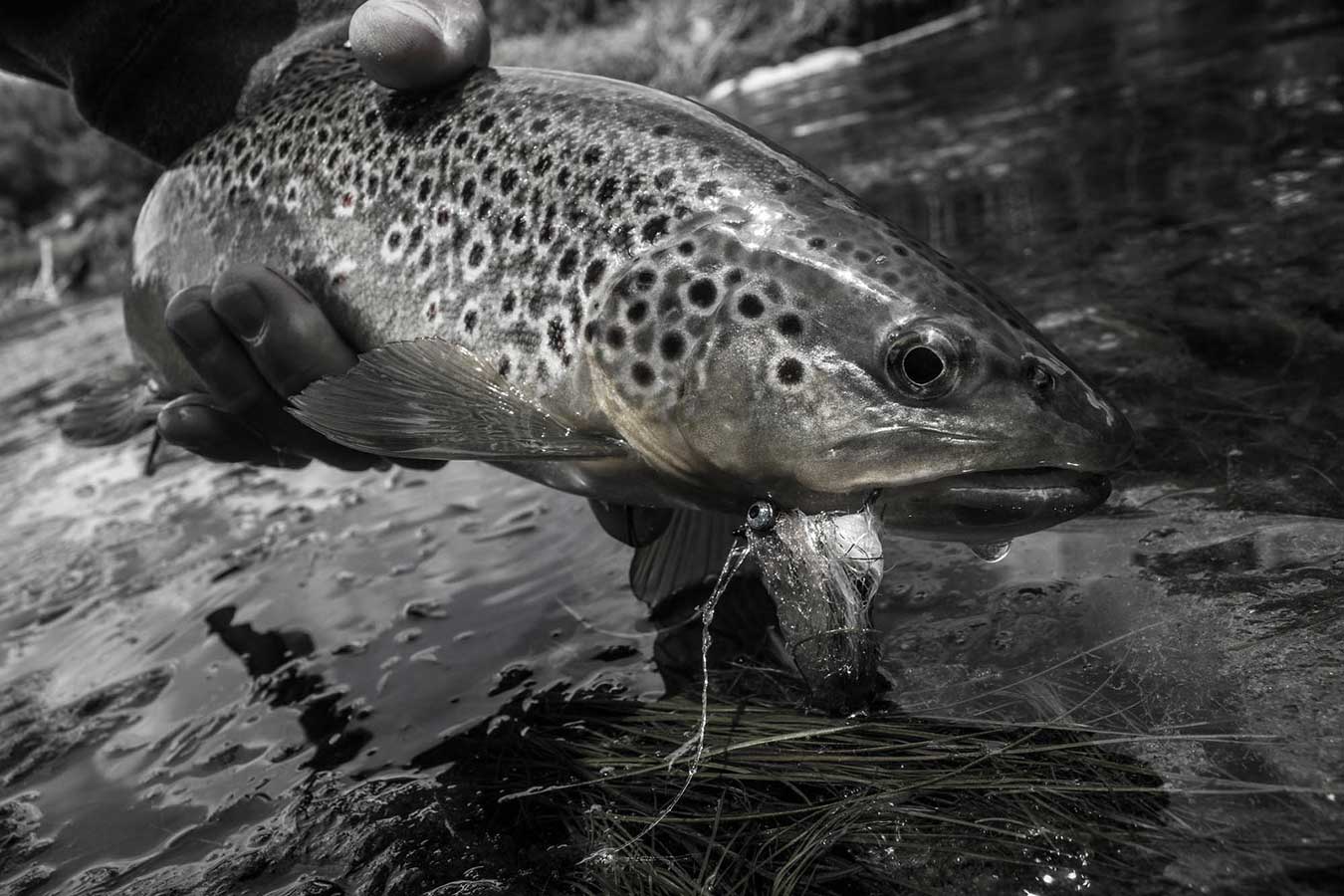
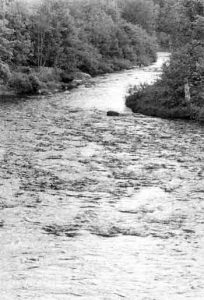
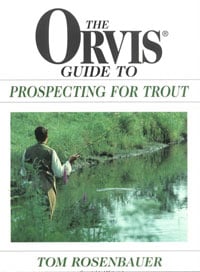
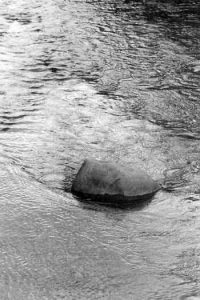
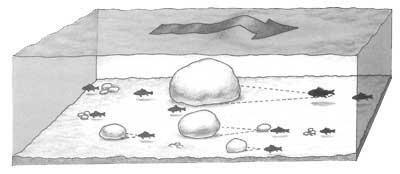
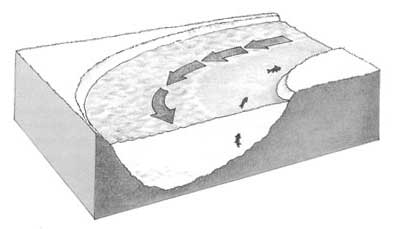
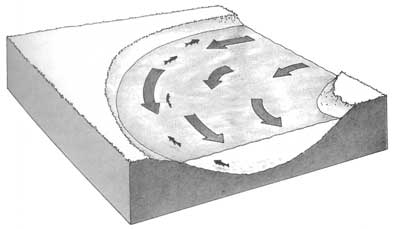
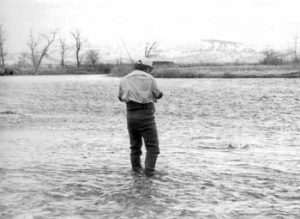
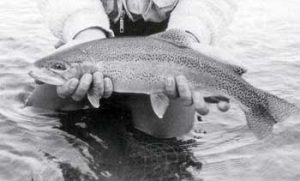
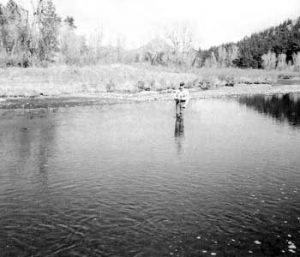

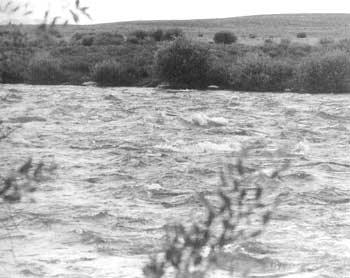
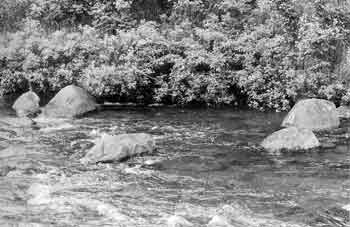
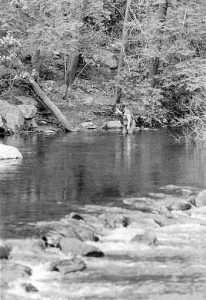
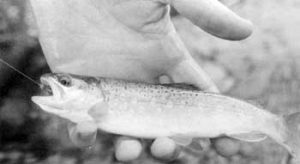
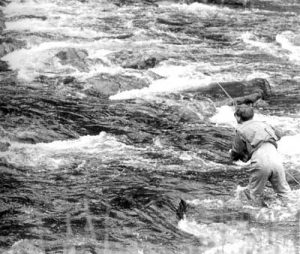
0 件のコメント:
コメントを投稿